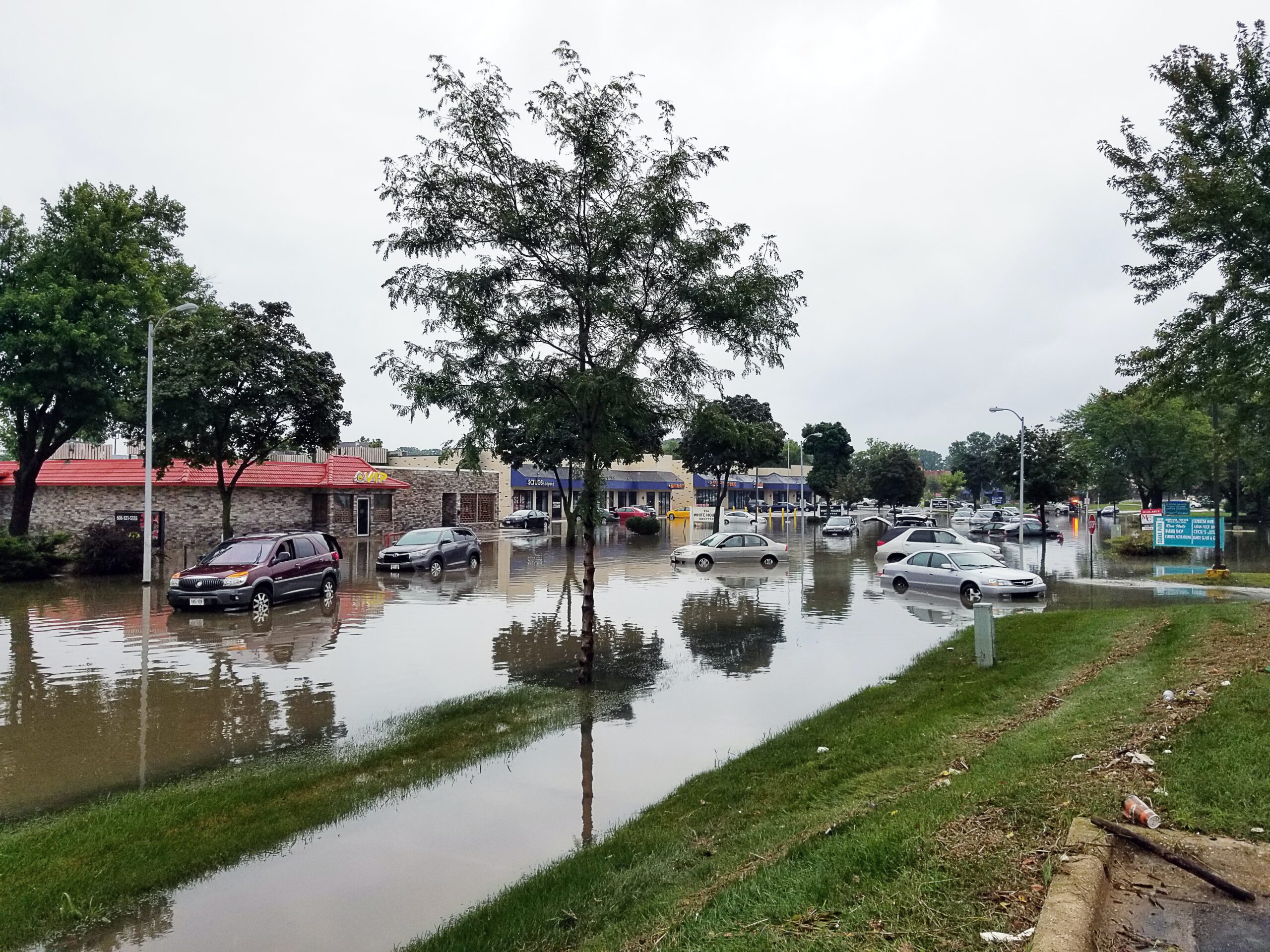By Sanjiv Sinha, Ph.D., PE
“Flooding in the Chicago area has been so bad in the past decade that only places ravaged by hurricanes sustain more damage.”
So blared the headline from a May 2019 Chicago Tribune post, just one example of headlines trumpeting the rampant flooding urban cities face across the Great Lakes Region. The combination of antiquated real estate development, loss of forest cover, outdated hydrologic conveyance systems, and increasingly extreme changes in hydrologic patterns in the region, have led to massive flooding issues and declining water quality in cities like Chicago, Cleveland, Detroit, and Milwaukee, among others. A new approach is required.

‘Green Streets’ and other similar Green Stormwater Infrastructure (GSI) practices are a logical answer. GSI relies upon a systemic framework of green spaces, parks, and pervious surfaces to filter stormwater runoff and increase water retention in soil and groundwater, rather than corralling and controlling water through a ‘gray’ system of gutters, sewers, and pipes. It has rapidly emerged as a critical, affordable, and effective component of resilient water infrastructure across the Great Lakes.

A newly released report “Climate Risks and Opportunities in the Great Lakes Region,” outlines a clear path forward for GSI. If framed well, GSI can cost less than conventional gray infrastructure, result in green jobs, and lead to improved real estate prices.
For example, the Milwaukee Metropolitan Sewerage District’s 2035 vision plan to build GSI is expected to yield cost savings of over $44 million, create 500 green jobs, and increase property values by $667 million.
The report focuses on the importance of four drivers of community resiliency. They include the risk of flooding and other climate risks; workforce development opportunities such as the re-hiring of existing and skilled workers; gaps in health and wealth; and building funding and financing capacity to pay for these improvements and projects.
The research focused on the eight-state, 653-county area that comprises the U.S. portion of the Great Lakes and integrated over 100,000 data points of 15 factors to create an innovative composite scoring system. This study evaluated items such as flood risk, impervious surfaces, vulnerability index, unemployment rates, skilled worker density, and financing capacity – into one overall score of resilience readiness.

The report includes ranked data on all 653 counties in the Great Lakes states and concludes the leading urban candidates for critical green stormwater infrastructure investment:
- Cleveland metro area and Cuyahoga County, Ohio;
- Milwaukee metro area and Milwaukee County, Wisconsin;
- Chicago metro area and Cook County, Illinois; and
- Detroit metro area and Wayne County, Michigan.
Smaller cities and mid-sized counties, that also are prime candidates include:
- Lucas County, Ohio;
- Lake County, Indiana;
- Ingham County, Michigan;
- Erie County, Pennsylvania;
- Isabella County, Michigan; and
- St. Joseph County, Indiana.
The conclusion summarizes research findings and elucidates key trends for prioritizing investing. Commonalities among the “best fit” counties include: a) large urban centers, b) worse inequality and concentrations of vulnerable populations, c) higher educational attainment, d) greater unemployment and job need, and e) being geographically situated in floodplains (including both urban impermeable surfaces and agriculturally tiled areas).
Importantly, this work can serve as a resource for investing in underrepresented communities and communities of color in particular. There is a strong correlation between a county’s final composite score and its population percentage people of color. As sites of historical disinvestment and structural barriers to equitable economic growth, these counties may be poised to derive some of the greatest benefits from investment in GSI guided with a justice-oriented approach.

The most populous cities in the Great Lakes, and several former manufacturing hubs, face serious threats from climate, unemployment, and lower quality of life –– unless they route more funding and investment into green infrastructure.
Upcoming Event: Wednesday, March 17, 2021
Join the authors of the report for a virtual dialogue hosted by the Council of the Great Lakes Region, Wednesday, March 17 from 3:30 pm-4:45 pm ET (2:30 pm-3:45 CT). Register for the event here.
About the Report
Led by San Francisco based sustainable investing expert HIP Investor, Inc. (HIP) and supported by national consulting firm Environmental Consulting & Technology, Inc. (ECT), the report is a product of an initiative Resilient Infrastructure Sustainable Communities or RISC. Funded by the Great Lakes Protection Fund, RISC is led by ECT, and includes collaborators from across the country, including HIP, New York Based climate-action nonprofit CDP, Chicago-based community-expert Center for Neighborhood Technology (CNT) and think/action-tank The Delta Institute.
Further details on RISC’s work can be accessed at www.risc.solutions.
About the Author

Sanjiv K. Sinha, Ph.D., P.E. is a Senior Vice President & a Board Member at Environmental Consulting & Technology, Inc. (ECT), an employee-owned, multidisciplinary engineering consulting firm based in the United States. A frequent presenter on topics related to climate resilience impacts and economic instruments within the infrastructure market, he aspires to make these ideas mainstream.
Currently, he manages Resilient Infrastructure Sustainability Communities and is credited with helping initiate two of the largest green stormwater infrastructure projects across the nation (an upcoming $60 Million environmental impact bond for Buffalo Sewer Authority, and a $20 Million community-based public private partnership for Milwaukee Metropolitan Sewerage District).
In 2020-2021, Dr. Sinha served as the vice chairman of the Board of Directors of Delta Institute, a nonprofit based in Chicago; and as an advisor to the WaterWorks Fund, an equity crowdfunding start-up that is focused on meeting water infrastructure/technology financing needs. Previously, he was the chairman of the Board of Directors for Alliance of the Great Lakes.
Photo by Jim Gade on Unsplash Madison, WI flood
Photo by Benjamin Rascoe on Unsplash Lincoln Park, Chicago



